

A frog is a type of tailless amphibian found all over the world. They’re short-bodied, smooth-skinned, and strong jumpers. Keep reading to find out tons of fun facts about frogs!


Frogs are one of the largest and most diverse groups of amphibians on Planet Earth. Scientists have documented thousands of frog species, and many feature unique traits perfectly adapted to their environment.
Frogs can live in woodlands, swamps, meadows, tundras, and even deserts. Depending on the habitat in which it lives, a frog might spend most of its days swimming in lakes and ponds or climbing up into the canopy of a rainforest tree. Frogs that live in drier parts of the world might bury themselves in a hole in the ground to wait for the rainy season.
They can be the predators in an ecosystem, gobbling up invertebrates and keeping insect populations in check. They can also be the prey, providing a tasty snack for local birds and reptiles. They can even be poisonous, with bright colours warning off potential threats.
Frogs are fantastic, aren’t they? Read on for more information about their life cycle, habitat, and diet.
The difference between frogs and toads is primarily in how they look. Toads are squatter than frogs, with shorter legs better suited for crawling than hopping or leaping. Where frogs have smooth, moist skin, toads have dry skin that tends to be warty and bumpy.
These physical characteristics mean that toads can deal with drier environments more easily than frogs. They live on dry land and only return to water to breed, resulting in a slight difference in behaviour.
|
Did you know? Frogs and toads are both in the same order Anura. All toads are technically frogs – though not all frogs are toads. We think of them as two distinct groups because of folk taxonomy, a system of organising and classifying things by cultural tradition (as opposed to scientific characteristics). |
Frogs are a vital part of any ecosystem. In the food chain, they function as both predator and prey.
Adult frogs eat vast quantities of insects, including those that can transmit diseases to humans (like mosquitoes).
Frogs also provide a valuable food source for creatures like snakes and birds. Frogspawn and tadpoles are eaten by insects and fish.
Frogs are also known as environmental indicators. They can absorb toxic chemicals through their skin, making them sensitive to changing water or air quality. This means declining or diseased frog populations can be an early warning sign of pollution.
| Type | Amphibian |
| Diet | Carnivore |
| Habitat | Varied – woodland, rainforest, swamp, desert, etc. |
| Life Span | 2 – 10 years (in the wild) |
| Located | Worldwide, on every continent except Antarctica |
| Kingdom | Animalia |
| Phylum | Chordata |
| Class | Amphibia |
| Clade | Salientia |
| Order | Anura |
| Suborders | Archaeobatrachia, Mesobatrachia, Neobatrachia |
Download our FREE Frog Colouring Page today!
Frogs have a set of distinctive characteristics that set them apart from other amphibians. Features to look for include:
Frogs are best known for having green, brown, or grey skin; however, some frog species are bright yellow, orange, red, or purple. These are often found in tropical environments, where their colours are helpful for camouflage or to ward off predators.
Most frogs are excellent swimmers. They have adaptations which help them move through the water, including powerful hind legs. When a frog swims, it kicks out with both legs simultaneously to propel itself.
Similarly, a frog’s webbed feet help it swim. When they stretch out their toes, the flaps of skin in between them increase the surface area of their feet, giving them extra power in the water.
Yes! All amphibians are cold-blooded, including frogs. This means that their body temperature matches the temperature of the air around them.
Common frogs in the United Kingdom hibernate during winter when the temperature drops.
Frogs are born with gills as tadpoles, but they don’t keep them for their whole life. Frogs lose their gills as they grow up into adults and develop lungs.
When frogs are young tadpoles, they can breathe underwater through their gills.
Adult frogs can also breathe through their skin, although they need to keep it moist for this to happen. If their skin is dry, they can’t absorb the oxygen in the air.
This process also allows them to breathe underwater for some time. It only works if there is enough oxygen in the water. If there isn’t enough, they risk drowning, just like any other creature with lungs.
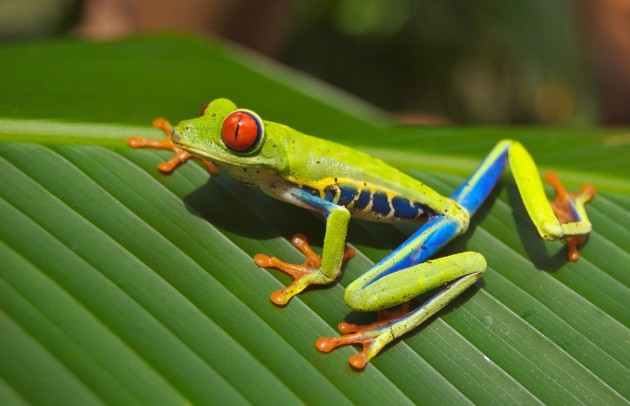
Frogs hatch from frog eggs to begin life as tadpoles, then grow into juvenile froglets.
Finally, they develop into adult frogs.
Some frogs in other parts of the world may have a different life cycle.
For now, let’s look at the life cycle of a common frog in the United Kingdom.
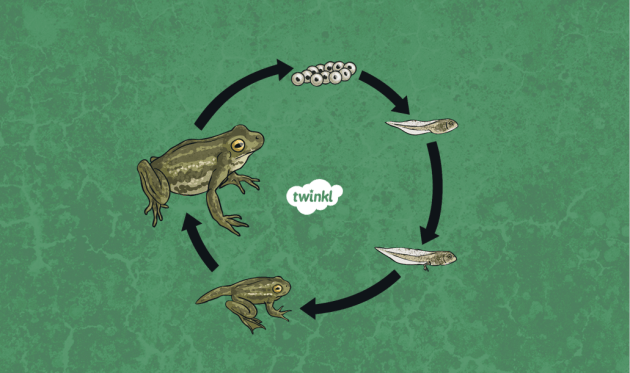
Frog eggs, also known as frogspawn, are laid in the water by an adult frog in the spring.
These eggs look like tiny black dots surrounded by translucent gel. The ‘dots’ develop a tail before hatching, becoming comma-shaped.
After about 6 to 21 days, these eggs hatch into tadpoles.
Tadpoles spend their time in the water, eating plant material and growing larger. They have a tail to help them swim and gills which allow them to breathe underwater.
Tadpoles usually take six to nine weeks to fully develop, though this depends on the type of frog. Through metamorphosis, they grow back legs and front legs. Over time, they also lose their gills, and their tail shrinks.
After undergoing metamorphosis, the tadpole becomes a froglet: an immature frog that is now prepared to live a semi-aquatic life. It will usually reach this stage by 12 weeks, appearing like a smaller version of an adult frog with fully-developed legs and arms.
They can leave the water and hop around on land; however, they’ll still spend most of their time in the water to survive.
Froglets often still have their tail, which will be absorbed before they become fully-grown adults.
At the end of the frog life cycle, the adult frog lives on land, but it returns to the water to breed and lay its eggs. This process is called spawning.
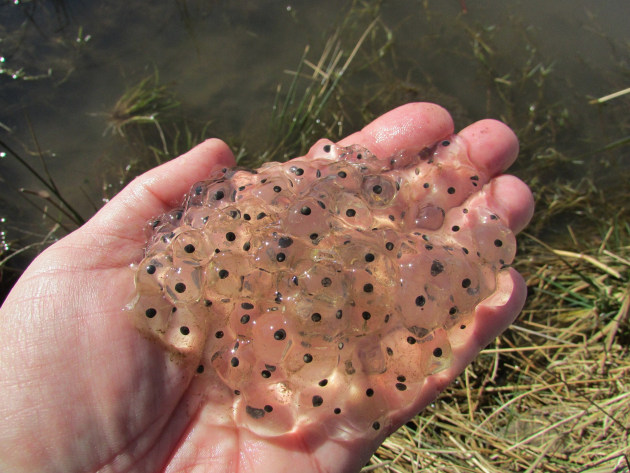
As mentioned previously, frogs are carnivorous. What they eat depends on what part of the world they live in and what stage of the frog life cycle they are currently in. Generally speaking, frogs will feed on insects and invertebrates.
Tadpoles are herbivorous. Unlike adult frogs, frogs eat nutritious algae and decaying plant matter as they grow and develop.
When they absorb their tails as froglets, their diet changes to include more nutritious food. These include tiny insects like fruit flies. They catch these with their long, sticky tongues.
Adult frogs will eat crickets, spiders, moths, slugs, snails, and worms.
Some large frog species, such as the African bullfrog (Pyxicephalus adspersus), can even eat mice.
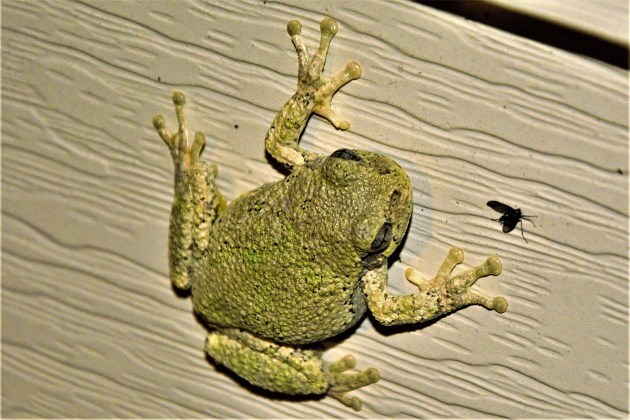
Frogs are adaptable creatures who live in a diverse range of habitats – hot, cold, wet, and dry.
Frogs can be found in Europe, North America, South America, Asia, Africa, and Oceania. In other words, all over the world!
In the United Kingdom, common frogs live in wet environments with a body of freshwater nearby. You can find them in wooded areas, hedgerows, or even in your own back garden!
Just like all living things, frogs need access to water, food, and shelter.
The ideal frog habitat has a permanent water source, such as a pond or a stream. It shouldn’t be too deep or too steep, as the frogs will need to be able to leave the water regularly.
Vegetation is crucial for providing shelter from the elements, protecting them during hot, sunny weather that could dry out their skin. Plants also offer protection from predators and effective camouflage. Tadpoles will also eat plant matter that ends up in the water.
Lastly, a reliable food source is a must-have for a frog looking for a new home. The more insects, the better!
So, what kinds of frogs are there? Here are a few of our favourite frog species:
The common frog (Rana temporaria) is found throughout northern Europe, including the United Kingdom. It’s also known as the grass frog. You can spot them all year round, though they’re most active between spring and autumn.
These frogs come in many colours, including green, grey, brown, and yellow. Their skin can change shade to match their surroundings.
As the name suggests, tree frogs are a type of frog that spends most of its life in the trees. They’re adapted to live far above the ground, with small, light bodies that allow them to jump further and avoid injury when falling from a great height.
Many species of tree frogs blend in with their environment with expert camouflaging skills. They may also have natural adaptations and advantages that help them survive in the canopies, such as super-adhesive toe disks that stick to the bark of the trees.
Poison dart frogs are a group of frog species native to South America’s tropical rainforests. They’re well-known for their bright colours and highly-toxic secretions. This is a famous example of aposematism: a process by which a prey animal warns potential predators that it is dangerous or not worth eating.
Many species of poison dart frogs are threatened by deforestation and the loss of their habitats.
Bullfrogs, also known as the American bullfrog (Lithobates catesbeianus), are the largest of all native frog species in North America. Male bullfrogs make a unique noise that sounds like a cow or a bull – hence the name.
Because of their size, their appetites aren’t satisfied with flies and moths. Bullfrogs use the cover of darkness to ambush mice, birds, and even snakes.
There are actually hundreds of species of flying frogs – frogs which are so aerodynamic that they can ‘fly’. The ability has evolved in some frogs that live in trees. They develop features that allow them to glide through the air, including extra webbing and skin flaps.
A famous species of flying frog is called ‘Wallace’s flying frog’ (Rhacophorus nigropalmatus). This frog lives in the tropical jungles of Indonesia, Borneo, and Sumatra.
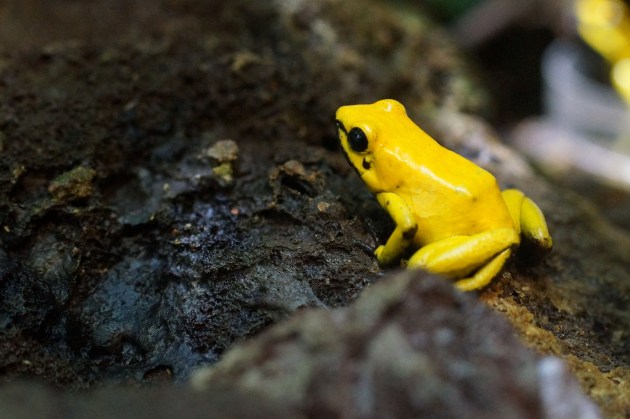
 Use augmented reality to get an up-close look at the dart frog with our 3D model!
Use augmented reality to get an up-close look at the dart frog with our 3D model!
Teach your class about the stages of a frog’s life cycle with this beautifully illustrated Frog Life Cycle PowerPoint. It’s the perfect introduction to our favourite amphibians, featuring age-appropriate descriptions and helpful definitions for EYFS children.
Test your learners’ knowledge of the frog life cycle with this printable Life Cycle of a Frog Activity Sheet. Children are asked to cut and stick the pictures into the correct order, using the provided word bank to help them identify each stage. It’s ideal for KS1 lessons on living things and their habitats.
After learning all about frogs and their features, why not create your own with the help of these Origami Hopping Frog Craft Instructions? Origami is a fantastic boredom buster and a brilliant way to practise hands-on craft skills. Break out the origami paper and create a whole army of fabulous frogs!